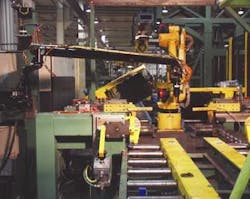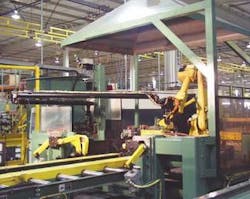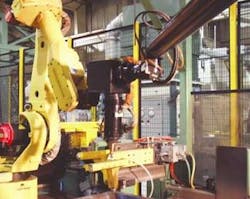Lasers and robots to the rescue
When production at a major automotive company was threatened by the failure of one of its Tier One suppliers, the company assigned BBK Ltd. (Southfield, MI) to move in and take over the troubled supplier's operations top to bottom. BBK has an extensive history of helping the automotive sector in its supply chain management, by sustaining or resuming failing production lines and stabilizing companies in ways that not only have preserved and enhanced the profitability of the individual business, but have also protected the ongoing relationships of the OEMs, the Tier Ones and their sub-suppliers.
The supplier in question provides frame rails for large trucks, emergency vehicles and buses. In automotive assembly, construction of a vehicle starts with a steel framework to which the engine and body components are mounted. The two main sides of the frame, which run the length of the vehicle, are called the rails. The rails, in this case steel C-channels, are up to 43 feet in length and weigh up to 800 pounds. Because the same basic rail is used on an assortment of vehicles, they exhibit up to 100 variations in their final configuration with more than 1000 different option holes for purposes of routing fuel lines, electrical wiring, and providing access and mounting locations.
The rail was plagued by quality and safety issues as it suffered through a tedious and strenuous operation. The large, heavy rails had to be manually handled and manipulated. Because holes and cut-outs are required on all three sides of the C-channel, the rails had to be physically turned to present the sides for cutting. The holes were made by a combination of manual template drilling and manual plasma cutting. The plasma-cut holes exhibited poor edge quality with excessive roughness and heavy dross or slag that presented a danger of cutting the hands of the operators and, if left in place, would potentially allow for chafing of brake lines and electrical wires. The manual selection and placement of drilling templates led to the creation of incorrect hole patterns and inaccurate hole locations, producing excessive scrap, rejects and rework. The heavy labor and poor ergonomics created a potentially dangerous work environment with high employee turn-over and low morale. The plant was suffering from high cost over-runs and late deliveries, seriously jeopardizing the automaker's ability to produce vehicles.
BBK quickly analyzed and completely reprocessed the facility, specifically targeting the hole-cutting operation. "Our task," explains Steven Williams of BBK, "was to make the plant process-capable, or in other words, to turn it into a viable operation that would be able to produce the parts expected of it more effectively and efficiently. At the same time, our goal was to increase throughput and improve quality and safety." Ultimately, the plant was able to convert from a two-shift, 24-hours-per-day, six-days-per-week operation to a single-shift, eight-hours-per-day, five-days-per-week operation while maintaining production rates and improving part quality.
A key component of the plant's newfound success was the implementation of two laser-robotic cutting cells. BBK contracted systems integrator, Custom Machines Inc (CMI; Adrian, MI), which assembled a team of laser industry experts formed by Rofin Sinar (Plymouth, MI), Fanuc Robotics (Auburn Hills, MI) and Laser Mechanisms (Farmington Hills, MI).
Each of the two identical twin cells features a 5kW CO2 Rofin RF050 laser and a Fanuc ArcMate 120iB industrial robot. Enabling the laser and robot with a flexible beam delivery system is an articulated arm supplied by Laser Mechanisms. Laser Mechanisms also provided an automatic, non-contact capacitive height sensing cutting head. As the prime contractor and system integrator CMI provided the overall controls for the two laser cells as well as the conveyor system, which moved and staged parts into and out of the cells.
Robotic plasma cutting was initially considered, but was ruled out because of the same poor cut quality of rough edges and heavy dross exhibited by the manual plasma cutting. Plasma cutting also was unable to produce the small, 10mm to 12mm diameter, holes that comprised 25 percent of the cutting requirement. "Staying with plasma would have still required that we also maintain a piercing or drilling operation for those holes," Williams says. "In addition, we knew that the laser would be a much more flexible tool."
Waterjet cutting was eliminated from consideration due to the necessity of dealing with the disposal of waste by-products from that application. "Operational costs and consumables cost are much higher for waterjet than for laser," Williams notes.
When it came to laser, CO2 was opted over Nd:YAG mainly for cost issues. Jim Cann of Rofin Sinar points out that CO2 is less expensive than Nd:YAG in simple terms of dollars-per-watt. "In addition," he says, "due to the difference in wavelength, a Nd:YAG system requires a safety enclosure. This adds further cost and we also had limited space in fitting around the set production lines."
Cann adds that, "A traditional multi-axis laser system was also ruled out for the same reasons of cost and floor space. A robotic system is about half the size and, in general, is about 25 to 30 percent less expensive than a traditional five-axis or seven-axis laser system."
The use of an articulated arm provided a fully enclosed and sealed beam path and also allowed flexible integration with a robot. John Barney of CMI states, "With an articulated arm from Laser Mechanisms we were able to combine a CO2 laser to a robot in much the same way as you use a fiberoptic beam delivery system with a Nd:YAG laser.
"The system was designed so that the robot could access all three sides of the rail and, unlike the previous manual operation, the part could remain stationary during cutting. Because there was a relatively simple amount of articulation for the robot, the use of a Laser Mechanisms arm was ideal for this application." (Readers interested in a detailed description of the design and advantages of articulated arms can refer to the September 2002 issue of Industrial Laser Solutions for a feature article on these devices.)
Another key feature is that the new laser systems are fully automatic. A master controller at the beginning of the line is input with the model type that is to be batch run. The cell controller of the laser system then knows which hole pattern to select from a library of patterns that has been programmed and edited off-line.
The laser systems have proven to efficiently cut the 6-, 8- and 10-mm thick mild steel C-channel. The rails are pre-painted, so a low-power first-pass scribe is made to remove the paint, followed by a higher power second-pass final cut. Cann says, "This is not the first time that we've addressed laser cutting of painted surfaces with this type of method, but it is still fairly unique and required some extra planning and development work.
"In the end, even with the dual-pass cutting, we were still able to decrease cycle time. The previous manual cutting operation used to be the pacing operation of the line. Now, with the lasers, the cutting operation actually takes less time than the punch press.
In addition to improving part quality with better edge quality and more accurate hole locations; improving throughput with lower scrap, rejects and rework; and improving process safety by eliminating the manual handling and physical manipulation of heavy parts with sharp edges, the less labor-intensive and fully automated laser process is calculated to have produced a savings of about ten man-years in annual labor costs for the factory.
Mike DelBusso is a sales engineer with Laser Mechanisms. Contact him by e-mail at [email protected].



